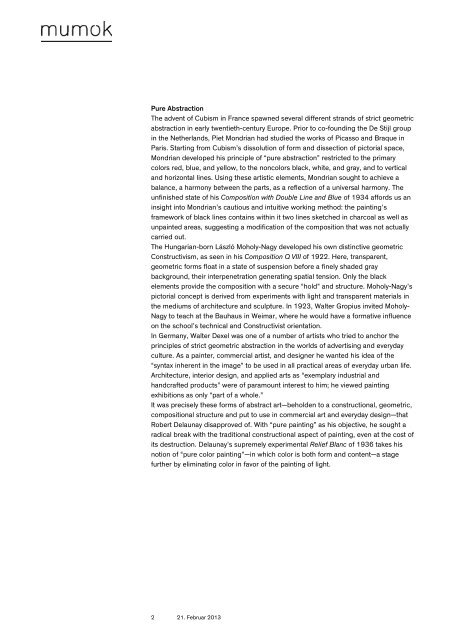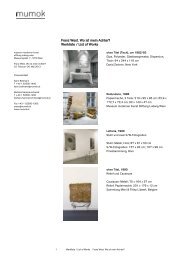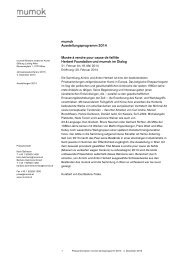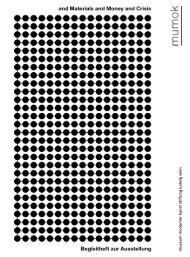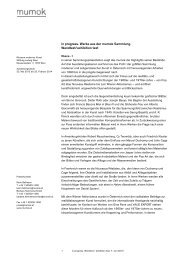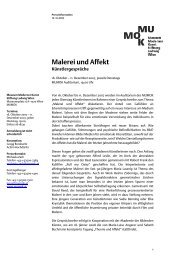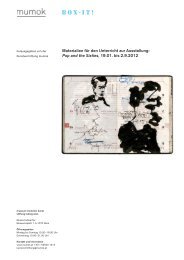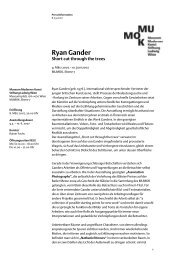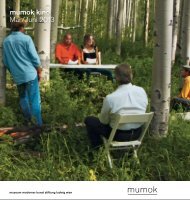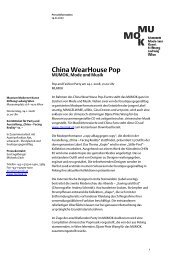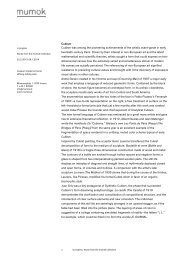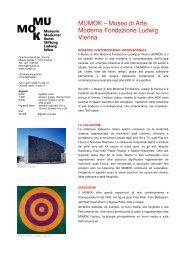in progress. Werke aus der mumok Sammlung Wandtext/exhibition text
in progress. Werke aus der mumok Sammlung Wandtext/exhibition text
in progress. Werke aus der mumok Sammlung Wandtext/exhibition text
Erfolgreiche ePaper selbst erstellen
Machen Sie aus Ihren PDF Publikationen ein blätterbares Flipbook mit unserer einzigartigen Google optimierten e-Paper Software.
Pure Abstraction<br />
The advent of Cubism <strong>in</strong> France spawned several different strands of strict geometric<br />
abstraction <strong>in</strong> early twentieth-century Europe. Prior to co-found<strong>in</strong>g the De Stijl group<br />
<strong>in</strong> the Netherlands, Piet Mondrian had studied the works of Picasso and Braque <strong>in</strong><br />
Paris. Start<strong>in</strong>g from Cubism’s dissolution of form and dissection of pictorial space,<br />
Mondrian developed his pr<strong>in</strong>ciple of “pure abstraction” restricted to the primary<br />
colors red, blue, and yellow, to the noncolors black, white, and gray, and to vertical<br />
and horizontal l<strong>in</strong>es. Us<strong>in</strong>g these artistic elements, Mondrian sought to achieve a<br />
balance, a harmony between the parts, as a reflection of a universal harmony. The<br />
unf<strong>in</strong>ished state of his Composition with Double L<strong>in</strong>e and Blue of 1934 affords us an<br />
<strong>in</strong>sight <strong>in</strong>to Mondrian’s cautious and <strong>in</strong>tuitive work<strong>in</strong>g method: the pa<strong>in</strong>t<strong>in</strong>g’s<br />
framework of black l<strong>in</strong>es conta<strong>in</strong>s with<strong>in</strong> it two l<strong>in</strong>es sketched <strong>in</strong> charcoal as well as<br />
unpa<strong>in</strong>ted areas, suggest<strong>in</strong>g a modification of the composition that was not actually<br />
carried out.<br />
The Hungarian-born László Moholy-Nagy developed his own dist<strong>in</strong>ctive geometric<br />
Constructivism, as seen <strong>in</strong> his Composition Q VIII of 1922. Here, transparent,<br />
geometric forms float <strong>in</strong> a state of suspension before a f<strong>in</strong>ely shaded gray<br />
background, their <strong>in</strong>terpenetration generat<strong>in</strong>g spatial tension. Only the black<br />
elements provide the composition with a secure “hold” and structure. Moholy-Nagy’s<br />
pictorial concept is <strong>der</strong>ived from experiments with light and transparent materials <strong>in</strong><br />
the mediums of architecture and sculpture. In 1923, Walter Gropius <strong>in</strong>vited Moholy-<br />
Nagy to teach at the Bauh<strong>aus</strong> <strong>in</strong> Weimar, where he would have a formative <strong>in</strong>fluence<br />
on the school’s technical and Constructivist orientation.<br />
In Germany, Walter Dexel was one of a number of artists who tried to anchor the<br />
pr<strong>in</strong>ciples of strict geometric abstraction <strong>in</strong> the worlds of advertis<strong>in</strong>g and everyday<br />
culture. As a pa<strong>in</strong>ter, commercial artist, and designer he wanted his idea of the<br />
“syntax <strong>in</strong>herent <strong>in</strong> the image” to be used <strong>in</strong> all practical areas of everyday urban life.<br />
Architecture, <strong>in</strong>terior design, and applied arts as “exemplary <strong>in</strong>dustrial and<br />
handcrafted products” were of paramount <strong>in</strong>terest to him; he viewed pa<strong>in</strong>t<strong>in</strong>g<br />
<strong>exhibition</strong>s as only “part of a whole.”<br />
It was precisely these forms of abstract art—beholden to a constructional, geometric,<br />
compositional structure and put to use <strong>in</strong> commercial art and everyday design—that<br />
Robert Delaunay disapproved of. With “pure pa<strong>in</strong>t<strong>in</strong>g” as his objective, he sought a<br />
radical break with the traditional constructional aspect of pa<strong>in</strong>t<strong>in</strong>g, even at the cost of<br />
its destruction. Delaunay’s supremely experimental Relief Blanc of 1936 takes his<br />
notion of “pure color pa<strong>in</strong>t<strong>in</strong>g”—<strong>in</strong> which color is both form and content—a stage<br />
further by elim<strong>in</strong>at<strong>in</strong>g color <strong>in</strong> favor of the pa<strong>in</strong>t<strong>in</strong>g of light.<br />
2 21. Februar 2013


